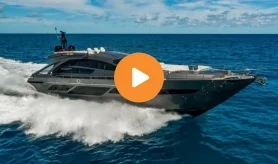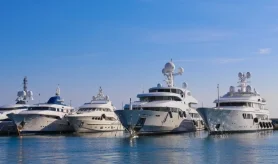- Alaskan Yachts
- Azimut Yachts
- Back Cove Yachts
- Beneteau Yachts
- Benetti Superyachts
- Bertram Yachts
- Boston Whaler
- Broward Yachts
- Buddy Davis Sportfish
- Burger Yachts
- Cabo Yachts
- Catamarans
- Carver Motoryachts
- Center Console
- Chris-Craft Yachts
- Cruisers Yachts
- DeFever Trawlers
- Dufour Sailboats
- Fairline Yachts
- Feadship Yachts
- Ferretti Yachts
- Formula Yachts
- Fountaine Pajot Cats
- Grady-White
- Grand Banks Trawlers
- Hargrave Yachts
- Hatteras Yachts
- Hinckley Picnic Boats
- Horizon Yachts
- Hydra-Sports
- Intrepid Boats
- Jarrett Bay Sportfish
- Jeanneau Yachts
- Kadey-Krogen Trawlers
- Lazzara Yachts
- Lekker Boats
- Luhrs Sportfish
- Marlow Yachts
- Maritimo Yachts
- Marquis Yachts
- Mazu Yachts
- McKinna Motoryachts
- Meridian Yachts
- Midnight Express
- MJM Yachts
- Mochi Craft
- Neptunus Motoryachts
- Nordhavn Trawlers
- Nordic Tugs
- Numarine Yachts
- Ocean Alexander Yachts
- Ocean King
- Offshore Yachts
- Outer Reef
- Oyster Sailing Yachts
- Pacific Mariner Yachts
- Palmer Johnson Yachts
Creative Combustion: Superyacht Designs of BRAVO EUGENIA and KISMET
Two rockstar design teams collaborate to create sublime superyachts together.
This article was written by Jill Borrow. Photography courtesy of Blueiprod Unless Otherwise Stated.
What do the 357-foot, Oceanco-built M/Y Bravo Eugenia and the 400-foot, Lürssen-built M/Y Kismet have in common? Well, in terms of visuals—not much at all. They sport distinctive profiles that bear no resemblance to each other, and they have extremely disparate interior designs. Still, there is common ground. The two represent a collaboration between Italy- based Nuvolari Lenard and UK-based Reymond Langton—two well-known rockstar superyacht design studios.


Both NL and RL have been responsible for designing some of the world’s most iconic superyachts afloat. Bravo Eugenia and Kismet belong to that category. In the case of each yacht, NL was the exterior designer and RL was the interior designer.
Coincidentally, both yacht owners are Americans who own NFL teams. Jerry Jones, owner of Bravo Eugenia, owns the Dallas Cowboys, and Shahid Khan, owner of Kismet, owns the Jacksonville Jaguars as well as the Fulham FC of the Premier League. Also, he is co-owner—along with his son, Tony Khan—of All Elite Wrestling.
Bravo Eugenia, delivered in 2018, debuted Oceanco’s LIFE Design platform—the acronym is derived from its description as “Lengthened, Innovative, Fuel-efficient, and Eco-friendly.” She has a single tiered engine room allowing for an optimized long and slender hull shape, resulting in a reduction in overall propulsion power demand. Nuvolari Lenard created a streamlined exterior. “The proportions of Bravo Eugenia were divided so that one third of the yacht would have free deck aft of superstructure and two thirds forward,” says Carlo Nuvolari, partner in Nuvolari Lenard. “Bravo sports what we call the ‘arrow’ shape whereby the volume of superstructure is wider than the aft part.”

“We worked closely with Nuvolari Lenard on the exterior styling,” says Jerry Jones. “For instance, we went back to the drawing board on several occasions to get the bow just right… “We experimented with several bows,” recalls Nuvolari. “In the end we and the owners collaboratively decided on a vertical shape to maximize the waterline length, with a straight but slightly reversed bow—a kind of submarine-type shape. In general, a military look was adopted, adorned by a stainless-steel stem.”
Another important line is the arch connecting the aft deck with the upper part of the superstructure via the glass fashion plates. These plates connecting the decks are aesthetically important, but they also have a fundamental practical effect: they protect the guests from the wind and also allow long-ranging views when sitting on aft decks.

Bravo Eugenia was Reymond Langton’s first collaboration with both Oceanco and Nuvolari Lenard. “The interior design is contemporary with a calm atmosphere formed from light quilted maple wood, with contrasting architectural elements of Macassar ebony and ebonized walnut floors,” says Pascale Reymond, partner in Reymond Langton. “Pearlized lacquers and natural finishes such as ivory onyx, mother of pearl, and rock crystal add a refined level of detail.”
RL worked with artisans and craftsmen such as Based Upon, Nature Squared, and Silverlining in creating bespoke artworks, natural finishes, and signature furniture pieces. It is common for Reymond Langton to become intricately involved in artwork and custom pieces woven into their various yacht designs. They did the same with Kismet, using bespoke suppliers such as Based Upon and anodized aluminum specialists Neal Feay.

Yacht designers and architects often have the reputation of being ego driven and overly interested in creating odes to their design brands. However, In the case of Bravo Eugenia and Kismet, the designers were dealing with owners who themselves had strong opinions. Nuvolari Lenard and Reymond Langton had to listen carefully.
Dan Lenard, partner in Nuvolari Lenard, has been known to remark that “most people never see the interior of a yacht but if they are out on the water, a yacht’s exterior is what makes an impression.” Kismet’s long, sweeping, midnight blue hull with its pointy bow is highly recognizable. Not just another white, tiered wedding cake of a superyacht, she has created a stir wherever she has been spotted—in Monaco along the quay, under London’s Tower Bridge, docked in Jacksonville, Florida, and anchored off St. Barths.

One particularly defining feature of Kismet’s superstructure is her funnel mast, which Nuvolari says resembles a large Samurai helmet. Metaphorically speaking, it is a sign of power and dominance—and contains the stylistic element of the “K” of Kismet, which is found in the bottom of the swimming pool and has become the ubiquitous logo of the yacht. Another unique NL design element is the slender bow with very long bowsprit—beneath which is the striking Art Deco silver jaguar figurehead.

As Reymond Langton was also responsible for the interior design of the previous two Kismets, a 68-meter and a 95-meter, they had already established a good working relationship with the Khans. “They challenged us to push the boundaries of innovation and creativity and to surpass previous accomplishments,” says Reymond. “Mr. K sought a yacht that was not just an extension of his previous vessels but something entirely new—avant garde, yet timeless.” And while that does seem like a contradiction in terms, Reymond shrugs and calls the yacht design “a floating land of contrasts.”

The main salon features two mesmerizing double-height video walls, made possible by two atriums and glass floors spanning from the main deck to the upper deck. The video walls on opposite sides of the salon entrance are individually controlled to display infinite types of programmed scenes or to reflect the outside environment. All of the interior spaces are dramatically sumptuous utilizing polished marble, glass, mirrors, and grand chandeliers. There is hand-painted de Gournay wallpaper, and a fresco ceiling inspired by the Sistine Chapel.

Kismet’s interior feels like walking onto a glamorous movie set. Pascale Reymond, who always has a bubbly personality, was practically bouncing up and down as she toured Kismet with me. “Imagine you are a time traveler,” she says, “and we are at a costume ball at Versailles, perhaps in the Galerie des Glaces [Hall of Mirrors] during Louis XIV’s rule. And now we move to an Art Deco theater in 1920s Hollywood.” Each area over the six decks is meticulously designed and curated to evoke a sense of discovery and wonder.
The staterooms reflect a contemporary twist on some of the owners’ favorite fashion designers and luxury brands. You can meander from 15th-century Venice to 17th-century Versailles to the Roaring Twenties of The Great Gatsby on Long Island. At the same time, you can immerse yourself in the world of Hermès, Coco Chanel, and Lalique. Then, just when you think you have been time traveling to a bygone era, you can fast forward to outer space with the TRON engine room corridor, where you have a great vantage point into the immaculate engine room.

Other standout features include the glass bulwark in the lower deck cinema and Nemo lounge, which has extra-large windows that dip below the waterline. Also onboard, there are three pools, four fireplaces, two fire pits, a spa with a hammam, sauna, and cryotherapy chamber, a gym, a basketball court, a pickleball court, and a helipad.
Both Bravo Eugenia and Kismet are complex constructs. There are many technical considerations for superyachts of their magnitude. Design teams such as Nuvolari Lenard and Reymond Langton are certainly imaginative, creative, and savvy, but they cannot simply take off on flights of fancy and wave a magic wand; collaboration among the builders, suppliers, engineers, owners, and fellow designers is key. Given Bravo Eugenia and Kismet, Nuvolari Lenard and Reymond Langton have demonstrated that they not only can give their personal best, but they are team players as well.

Request a Copy






